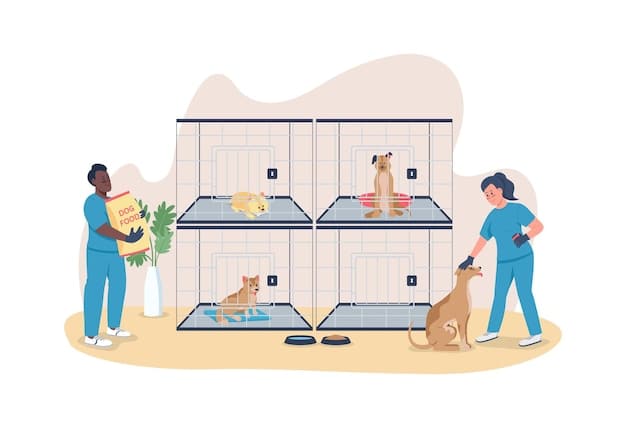Streamlining Shelter Operations: Cut Costs by 10% in 6 Months

Streamlining shelter operations through strategic data analysis and targeted interventions can significantly reduce costs, with a well-defined plan enabling local animal shelters to achieve a 10% reduction in expenses within six months, optimizing resource allocation, and improving overall efficiency.
Local animal shelters often struggle with limited resources and increasing demands. Streamlining shelter operations: A data-driven guide to reducing costs by 10% in 6 months offers practical strategies and insights to optimize resource allocation, improve efficiency, and ultimately provide better care for animals in need while achieving significant cost savings.
Understanding Your Shelter’s Current Financial Landscape
Before implementing any cost-saving measures, it’s essential to understand your shelter’s current financial situation. This involves a comprehensive assessment of income sources, expenses, and key performance indicators (KPIs). A clear understanding of where your money is coming from and where it’s going is critical for identifying areas where costs can be reduced.
Analyzing Income Streams
Animal shelters typically rely on a variety of income sources, including donations, grants, adoption fees, and fundraising events. Understanding the contribution of each stream is vital. Evaluating historical data allows shelters to identify the most reliable and lucrative sources, informing resource allocation and fundraising strategies.
Categorizing Expenses
Categorizing expenses is a critical step in understanding the financial landscape. Common categories include: animal care (food, medical supplies, veterinary services), staffing (salaries, benefits), facility maintenance (rent, utilities, repairs), administrative costs (office supplies, insurance), and fundraising expenses.
Here are several key strategies for analyzing and optimizing your animal shelter’s budget:
- Detailed Budget Review: Conduct a line-by-line review of every expense category to identify potential areas for cost reduction.
- Benchmark Against Similar Shelters: Compare your shelter’s financial data with similar organizations to identify discrepancies and potential inefficiencies.
- Track Key Performance Indicators (KPIs): Monitor metrics like cost per animal, adoption rates, and fundraising efficiency to measure progress.

By thoroughly understanding and managing your shelter’s financial information, you’ll establish a solid foundation for data-driven decisions. This initial analysis will point out specific sectors where strategic adjustments can lead to considerable cost savings, ensuring that resources are allocated effectively and maximizing the impact of every dollar.
Leveraging Data Analytics for Streamlined Operations
Data analytics plays a crucial role in optimizing shelter operations and reducing costs. By collecting and analyzing data on various aspects of shelter management, you can identify bottlenecks, inefficiencies, and areas for improvement. This data-driven approach enables informed decision-making and targeted interventions.
Collecting Relevant Data
The first step in leveraging data analytics is to collect relevant data. This includes information on animal intake (species, age, health conditions), length of stay, adoption rates, medical treatments, supply usage, staffing schedules, and volunteer hours. Utilize your shelter’s existing software or implement new systems to gather this data systematically.
Identifying Key Metrics
Once data is collected, it’s essential to identify key metrics that provide insights into shelter operations. Consider metrics like: average length of stay for different animal types, adoption rates per species, cost per animal per day, medical treatment costs for common ailments, and staff-to-animal ratios.
Data analytics can transform your shelter through the following methods:
- Predictive Modeling: Use historical data to forecast future needs, such as animal intake and resource requirements, enabling proactive planning.
- Efficiency Analysis: Identify bottlenecks in processes like intake, medical care, and adoption to optimize workflow and resource allocation.
- Performance Tracking: Monitor KPIs over time to measure the impact of improvement initiatives and make data-driven adjustments.
Adopting data analytics allows shelters to move beyond guesswork and make informed decisions based on concrete evidence. This supports efficient resource allocation, reduces operational costs, and optimizes care for the animals.
Optimizing Animal Care and Medical Expenses
Animal care and medical expenses often represent a significant portion of a shelter’s budget. Implementing strategies to optimize these expenses can lead to substantial cost savings without compromising animal welfare. Preventative care, efficient resource management, and strategic partnerships are key to this approach.
Preventative Care Strategies
Investing in preventative care can reduce the incidence of illness and injury, lowering overall medical expenses. Regular vaccinations, parasite control, dental care, and nutritional support contribute to maintaining the health of the animal population. Promote these practices upon adoption to support long-term well-being.
Smart Purchasing and Inventory Management
Effective supply and medication procurement practices play a critical role in controlling expenses. Conduct regular evaluations of supplier contracts to negotiate favorable pricing, including bulk purchasing. Additionally, implement an efficient inventory management system to avoid overstocking or shortages, reducing waste.
Reduce animal care and medical expenses through these practices:
Strategic Partnerships with Veterinarians and Suppliers
Building relationships with local veterinary clinics and suppliers can lead to subsidized services. Exploring partnerships with veterinary colleges for student volunteer opportunities offers cost-effective care alternatives. Negotiating favorable terms with suppliers, particularly for bulk purchases of food and medical supplies, can provide considerable savings.
- Optimized Feeding Protocols: Implement standardized feeding guidelines based on the size, age, and health condition of each animal to minimize food waste.
- Efficient Medication Dispensing: Use automated dispensing systems to ensure accurate dosing and reduce medication waste.
- Early Disease Detection: Train staff and volunteers to recognize early signs of common illnesses, enabling timely intervention and preventing costly complications.

Adopting these optimized animal care and medical expense strategies not only contributes meaningfully to a shelter’s financial health but also boosts the overall standard of care for animals. By focusing on prevention, efficient resource use, and establishing solid partnerships, shelters can significantly reduce costs while ensuring the well-being of their animals.
Improving Staffing Efficiency and Volunteer Engagement
Staffing costs are a significant expense for animal shelters. Optimizing staffing efficiency and maximizing volunteer engagement can lead to substantial cost savings and improved operational effectiveness. Strategic scheduling, cross-training, and effective volunteer management are key to achieving these goals.
Strategic Staff Scheduling
Analyze staffing needs based on peak hours and seasonal trends to optimize scheduling. Implement flexible scheduling options and cross-training opportunities to ensure adequate coverage during busy periods and reduce the need for overtime pay. Utilize scheduling software to streamline the process and improve communication.
Enhancing Volunteer Programs
Engage volunteers to augment the workforce and reduce staffing costs. Develop comprehensive volunteer roles and training programs to ensure volunteers are prepared and effective. Recognize and appreciate volunteer contributions to foster a positive and productive volunteer team.
Here are efficient staffing and engagement techniques:
- Skill-Based Volunteer Assignments: Match volunteer skills with specific tasks, such as administrative support, animal care, or fundraising, to maximize their contribution.
- Continuous Training and Development: Provide ongoing training opportunities to enhance staff skills and knowledge, improving efficiency and reducing errors.
- Performance Management Systems: Implement performance management systems to track staff performance, identify areas for improvement, and provide constructive feedback.
By improving staffing efficiency and volunteer engagement, shelters can greatly cut costs and improve operational effectiveness. Prudent scheduling, thorough cross-training, and active volunteer management not only optimize resource use but also build a more skilled, engaged, and motivated workforce, significantly enhancing the welfare of the animals under care.
Optimizing Energy Consumption and Facility Management
Energy consumption and facility maintenance contribute significantly to a shelter’s ongoing expenses. Implementing energy-saving measures and optimizing facility management practices can substantially reduce these costs. Energy-efficient upgrades, proactive maintenance, and efficient waste management are key to achieving these savings.
Energy-Efficient Upgrades
Invest in energy-efficient upgrades to reduce utility costs. Consider installing LED lighting, energy-efficient HVAC systems, and smart thermostats. Conduct an energy audit to identify areas where energy consumption can be reduced. Explore rebates and incentives offered by utility companies to offset the cost of upgrades.
Proactive Maintenance and Repairs
Implement a proactive maintenance program to prevent costly repairs and extend the lifespan of equipment and facilities. Conduct regular inspections, perform routine maintenance, and address minor issues before they escalate into major problems. Maintain a detailed maintenance log to track repairs and maintenance activities.
- Water Conservation Strategies: Implement water conservation measures, such as low-flow fixtures and efficient irrigation systems, to reduce water bills.
- Space Optimization: Redesign shelter layout to maximize space utilization, ensure efficient workflow, and reduce the need for additional construction.
- Waste Reduction and Recycling: Implement waste reduction and recycling programs to minimize waste disposal costs and promote environmental sustainability.
By adopting sustainable approaches to facility management, such as the above strategies, shelters can make significant savings on energy, waste, and facility costs. Prioritizing energy efficiency, planning proactive maintenance, and lowering waste not only trims expenses but also builds a more sustainable and environmentally responsible organizational attitude.
Fundraising Strategies and Community Engagement
Effective fundraising and community engagement are essential for sustaining shelter operations and reducing reliance on limited resources. Diversifying fundraising efforts, building strong community partnerships, and leveraging digital marketing can significantly increase revenue and support. Strategic communication and donor cultivation are crucial to maximize fundraising success.
Diversifying Fundraising Efforts
Relying on a single fundraising source can be risky. Diversify fundraising efforts by exploring various channels, including online donations, crowdfunding campaigns, corporate sponsorships, grant applications, and fundraising events. Tailor fundraising strategies to appeal to different donor segments and leverage social media to promote fundraising initiatives.
Building Community Partnerships
Establishing strong partnerships with local businesses, community organizations, and schools can provide valuable resources and support. Collaborate with businesses for sponsorship opportunities, partner with organizations for joint fundraising events, and engage schools for volunteer recruitment and awareness campaigns. Recognize and appreciate community partners to foster long-term relationships.
- Digital Marketing and Social Media: Employ digital marketing and social media to reach animal welfare advocates.
- Donor Cultivation and Stewardship: Develop a donor cultivation and stewardship program to nurture donor relationships and encourage repeat donations.
- Impact Reporting and Transparency: Provide donors with clear and transparent reporting on how their contributions are making a difference in the lives of animals.
Investing in strategic fundraising and community engagement strategies will provide shelters with much-needed resources and increase community support. Diversifying income streams, forging strong partnerships, and leveraging digital platforms enable shelters to enhance financial stability and further their mission of caring for animals in need. These approaches also cultivate local goodwill and public awareness, building a solid foundation for lasting expansion and long-term effectiveness.
| Key Point | Brief Description |
|---|---|
| 📊 Data Analysis | Use data-driven insights for informed decision-making. |
| 🐾 Optimized Care | Improve animal health with preventative care. |
| 🤝 Community Support | Engage the community for fundraising and assistance. |
| 💡 Efficient Operations | Streamline processes to reduce waste and costs. |
Frequently Asked Questions (FAQ)
▼
Data analytics identifies inefficiencies, predicts resource needs, and monitors performance metrics. This information supports informed decision-making, leading to improved resource allocation and cost reduction.
▼
Regular vaccinations, parasite control, and dental care prevent costly illnesses. Good nutrition strengthens animal immune systems, reducing the need for extensive medical intervention.
▼
Offer varied roles matching volunteer skills, comprehensive training, and consistent appreciation. Highlight their impact, create a positive atmosphere, and provide opportunities for skill development to maintain engagement.
▼
Install LED lighting, smart thermostats, and energy-efficient HVAC systems. Conduct audits to identify areas for improvement and apply for utility rebates to offset the cost of these enhancements.
▼
Explore online donations, crowdfunding, corporate sponsorships, and grant applications. Utilize social media to promote fundraising initiatives and tailor strategies to engage with different donor segments effectively.
Conclusion
By implementing a data-driven approach to streamlining shelter operations, local animal shelters can achieve a 10% reduction in costs within six months. This involves understanding your shelter’s financial landscape, leveraging data analytics, optimizing animal care, improving staffing efficiency, and enhancing fundraising strategies. These measures work together to optimize resource allocation and enhance animal welfare.





